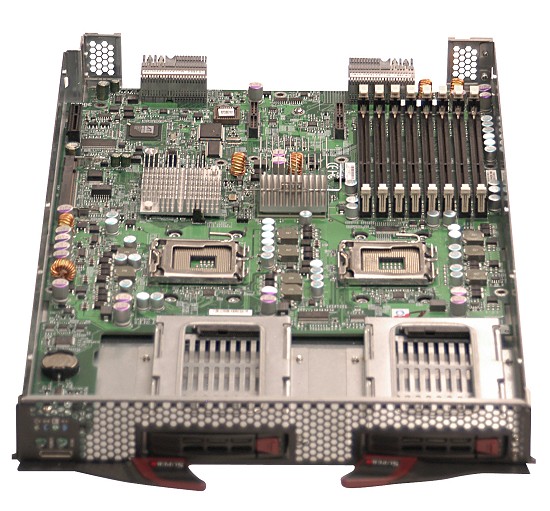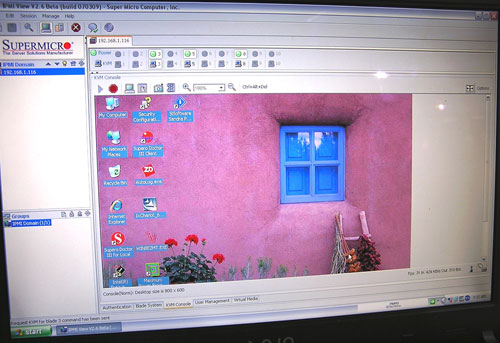CeBIT 2007: Storage & Servers
by Johan De Gelas on March 29, 2007 12:15 AM EST- Posted in
- Trade Shows
Superblade
In our first server guide we commented that "the idea behind blade servers is brilliant" but that the current blade server market is filled with relatively overpriced and "vendor lock-in" solutions. Blades are still proprietary, but there is a good chance that the blade market is going to be quite a bit more competitive now that Supermicro's Superblade is here. This puts Supermicro right up against the established blade server vendors such as HP, IBM, Sun and Fujitsu-Siemens...
We could not get Donn Clegg or Angela Rosario to give us the pricing of the Supermicro Superblade, besides the indication of "very competitive pricing". Still, there are indications that the Superblade Enclosure is going to stir things up. Considering that Supermicro sells as many servers as Sun and Fujitsu-Siemens combined, it is easy to see that even if Supermicro is considered a Tier 2 OEM, this move cannot be ignored by the Tier one OEMs.
The Supermicro Superblade is a 7U blade chassis, which can contain up to ten blades. Each blade can use up to four Socket-F Opterons, and Raphael Wong told us that the Superblade will make use of AMD's newest Barcelona (or K10) chip. This means that you can use up to 16 cores per blade, or no less than 160 (!) cores for the complete 7U chassis. The Superblade enclosure also supports blades with dual socket dual core Xeons (51xx) or quad core Xeons (53xx).

Another interesting aspect is the hard disk options. On a 2-way chassis you have the flexibility to go for either two 2.5" or 3.5" drives (either SAS or SATA). Best of all, you can buy your own hard disks; you are not forced to buy your disks from the blade chassis vendor, contrary to what is customary with the other blade manufacturers.

With the 4-way blade you can only use 2.5" SATA drives as the four CPU sockets take away the necessary space for 3.5" disks.

Three kinds of hot-swappable power supplies (1400W, 2000W, 2500W) can be used and the chassis can hold up to four power supplies in a 3+1 configuration. Up to two Gigabit Ethernet switches or up to two 4x DDR InfiniBand switches (20Gb/s per port) can be used for connectivity. The Gigabit Ethernet switches we saw were 10 port Gigabit switches. An (optional) InfiniBand switch will link to each blade server via their own InfiniBand card.

Each of the blade servers has an IMPI 2.0 management module connector, and Supermicro's own management solution was being shown with the server at CeBIT.
In our first server guide we commented that "the idea behind blade servers is brilliant" but that the current blade server market is filled with relatively overpriced and "vendor lock-in" solutions. Blades are still proprietary, but there is a good chance that the blade market is going to be quite a bit more competitive now that Supermicro's Superblade is here. This puts Supermicro right up against the established blade server vendors such as HP, IBM, Sun and Fujitsu-Siemens...
We could not get Donn Clegg or Angela Rosario to give us the pricing of the Supermicro Superblade, besides the indication of "very competitive pricing". Still, there are indications that the Superblade Enclosure is going to stir things up. Considering that Supermicro sells as many servers as Sun and Fujitsu-Siemens combined, it is easy to see that even if Supermicro is considered a Tier 2 OEM, this move cannot be ignored by the Tier one OEMs.
The Supermicro Superblade is a 7U blade chassis, which can contain up to ten blades. Each blade can use up to four Socket-F Opterons, and Raphael Wong told us that the Superblade will make use of AMD's newest Barcelona (or K10) chip. This means that you can use up to 16 cores per blade, or no less than 160 (!) cores for the complete 7U chassis. The Superblade enclosure also supports blades with dual socket dual core Xeons (51xx) or quad core Xeons (53xx).

Another interesting aspect is the hard disk options. On a 2-way chassis you have the flexibility to go for either two 2.5" or 3.5" drives (either SAS or SATA). Best of all, you can buy your own hard disks; you are not forced to buy your disks from the blade chassis vendor, contrary to what is customary with the other blade manufacturers.

With the 4-way blade you can only use 2.5" SATA drives as the four CPU sockets take away the necessary space for 3.5" disks.

Three kinds of hot-swappable power supplies (1400W, 2000W, 2500W) can be used and the chassis can hold up to four power supplies in a 3+1 configuration. Up to two Gigabit Ethernet switches or up to two 4x DDR InfiniBand switches (20Gb/s per port) can be used for connectivity. The Gigabit Ethernet switches we saw were 10 port Gigabit switches. An (optional) InfiniBand switch will link to each blade server via their own InfiniBand card.

Each of the blade servers has an IMPI 2.0 management module connector, and Supermicro's own management solution was being shown with the server at CeBIT.










13 Comments
View All Comments
Nehemoth - Thursday, March 29, 2007 - link
Well it was invented by AMD but was the code name for the Turion.Later indeed miss used over Internet....
Hope Barcelona be an Amazing chip, regards to AMD for the great products that Intel is Gave in us, yes sound really extrange but imagine where we would be if not for AMD..
CrystalBay - Thursday, March 29, 2007 - link
Fascinating analysis Johann ..JohanAnandtech - Thursday, March 29, 2007 - link
Thanks!With the current hints we got from Intel (Penryn Xeons might go to 3.6 GHz if necessary), I just hope AMD will do better than 2.3 GHz. Journalists like us need Epic battles ;-)